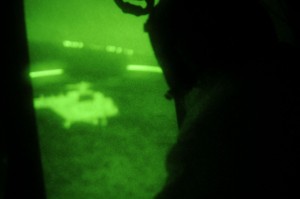U.S. Special Operations Command Europe (SOCEUR) recently hosted an aviation training program for the Croatian Air Force on the use of night vision goggles.
SOCEUR training initiative helps Croatian rotary wing pilots to fly with NVGs
By Master Sgt. Donald Sparks
SOCEUR Public Affairs
The 2010 Quadrennial Defense Review (QDR) highlighted the importance of increasing rotary-wing availability as one of the most significant elements to achieving success in large-scale counterinsurgency, stability, and counterterrorism operations worldwide.
A significant shortage exists, and nowhere is this shortfall more prevalent than in the special operations forces (SOF) community.[1] The challenge of deploying SOF personnel and military gear by air is considered one of the most crucial efforts to effectively engage the enemy as SOF missions increase in number and tempo.
In an ambitious plan to close this critical capability gap and to generate greater capacity for partner nation SOF, the U.S. Special Operations Command Europe (SOCEUR) hosted an aviation training program for the Croatian Air Force throughout the months of March and April 2010.
Utilizing private contractors with Department of Defense (DOD) oversight, SOCEUR planned and coordinated the training of eight Croatian pilots and their crew chiefs to fly their aviation platforms using night vision goggles, thus improving their night flying capability.
According to Lt. Cmdr. Daniel Silbermann, a SOCEUR J5 Air Planner, the training culminated several European partner development assessments on NATO rotary-wing shortages.
In coordination with U.S. embassies, SOCEUR identified two funding sources from among the various U.S. European Command (EUCOM) and Department of State (DOS) programs to initiate a conceptual training program. Those funding sources were the Counter Narcotics and Terrorism program and the Global Peace Operations Initiative.
“We followed up with Croatia, one of the newest NATO countries. Its Air Force also has brand new Mi-171 helicopters that can be utilized in support of military assistance to counter-narcotic training as well as peacekeeping operations,” Silbermann added. “One of their focuses is ensuring the integrity of their own international border against illegal activities relating to both narcotics and terrorism.”
In addition, because Croatia actively participates in the NATO Kosovo Force mission, GPOI funds could be used because of the direct and substantial benefit the training could have for the ongoing peacekeeping mission.
Maj. Michael Križanec, a seasoned Croatian Air Force pilot who has trained at Lackland Air Base in San Antonio was one of the beneficiaries of the NVG training. He mentioned that the training would have an immediate impact on all of the participating pilots and aircrews.
“Now we can use the helicopter to conduct low-level nighttime missions, and we can land on unprepared surfaces if we ever need to find someone and save them,” Križanec said. “We have a platform designed and built to fly missions using night vision goggles, but we previously had no trained pilots or crew chiefs to conduct the flights. So our capabilities are now tenfold better and we can do it safely – that’s the bottom line. We can insert and extract soldiers to a location at night, which is something we couldn’t do before.”
The Croatian NVG training has already met two end states, according to Silbermann.
The first is that the U.S. has provided Croatia capabilities that they didn’t have in the past. Within a month, Croatian pilots will be conducting real-world nighttime missions that they could have previously only conducted during the day.
He also expressed that as a result of the training, the Croatians now have an internal nighttime crisis response capability. Should they have a rescue situation and need to deploy a team at night for example, they now have that capability.
Elaborating more on his country’s newly acquired capability, Križanec remarked, “The people who have bad ideas and mean us harm can now think twice because darkness no longer provides a cover. I can finally say that we, Croatia, have finally stepped into the 21st century in terms of flying at night. The enemy can’t stay hidden under a cloak of darkness.”
SOCEUR achieved a second end state by finding an interim solution that U.S. SpecialOperations Command could potentially build upon in its Security Force Assistance development. Currently there is no U.S. aviation FID program that focuses on NVG training in Europe, but SOCEUR air planners hope to continue paving a way ahead and obtain more DOD and DOS funding support.
As for the Croatians, they are grateful for the opportunity to receive this training.
“Without U.S. assistance, this would not have happened at all,” Križanec said. “The amount of U.S. involvement here was tremendous. Whether you talk about organization, planning, equipment, financing, or pilot expertise, we could not have done this at all. The process of getting the NVGs and flying with them would have been a two to three-year process on our own, but the U.S. made it happen now.”
[1] Scully, Megan. 2010. Special ops forces face helicopter shortage. http://www.govexec.com/story_page.cfm?articleid=45139&oref=todaysnews (accessed April 29, 2010).
